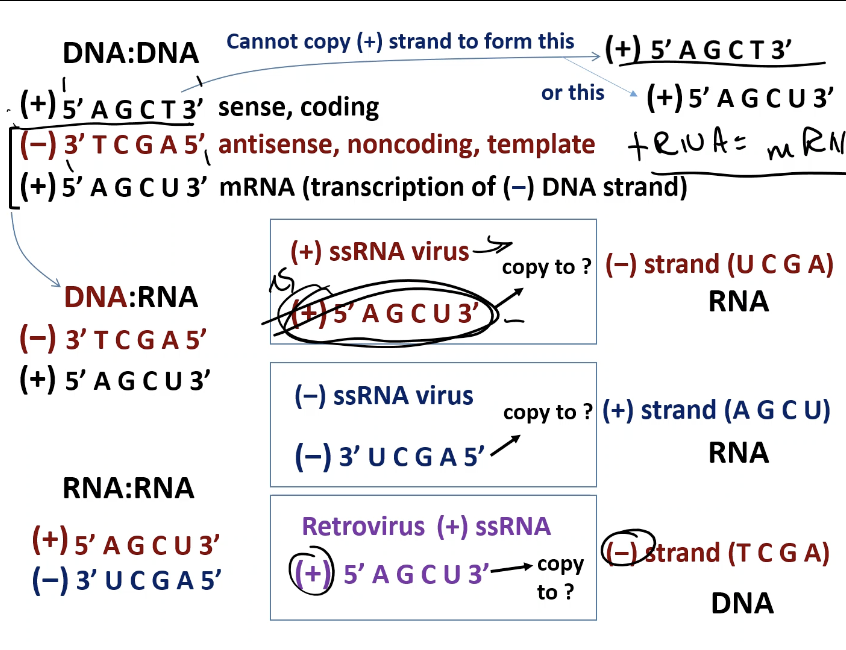chapter 13
1/54
There's no tags or description
Looks like no tags are added yet.
Name | Mastery | Learn | Test | Matching | Spaced |
|---|
No study sessions yet.
55 Terms
What is a virus?
Virus is not alive on its own
NONLIVING, must reproduce inside host cell
Ubiquitous and ecologically important
Acellular particle
Has no cells, no metabolism, no ribosomes, and cant make its own ATP
Genetic material (DNA/RNA) wrapped in a protein coat
Obligate intracellular parasite
Virus must infect a host to reproduce
When a virus infects a cell, it...
takes over the hosts machinery to make more copies of itself (new viruses are called virions)
Subverts the cells machinery and directs it to produce viral particles
Virions:
complete infectious virus ; outside of host cell
Cant reproduce
The big three
Coronavirus
Respiratory syncytial virus
Influenza virus
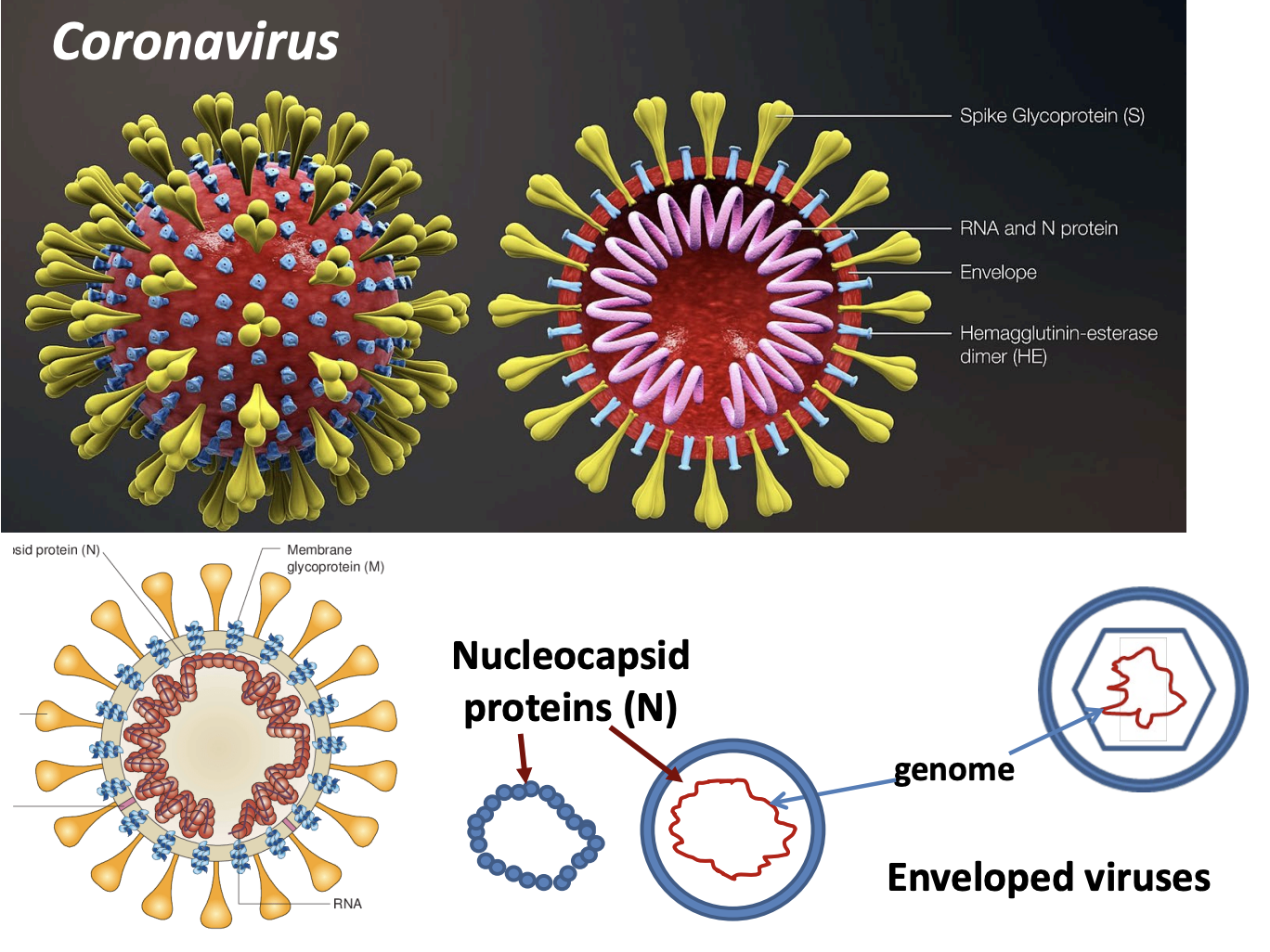
Coronavirus
(+) Ss rna
Nucleoid capsid proteins bind to genome
Protects genome by binding instead of boxing it in
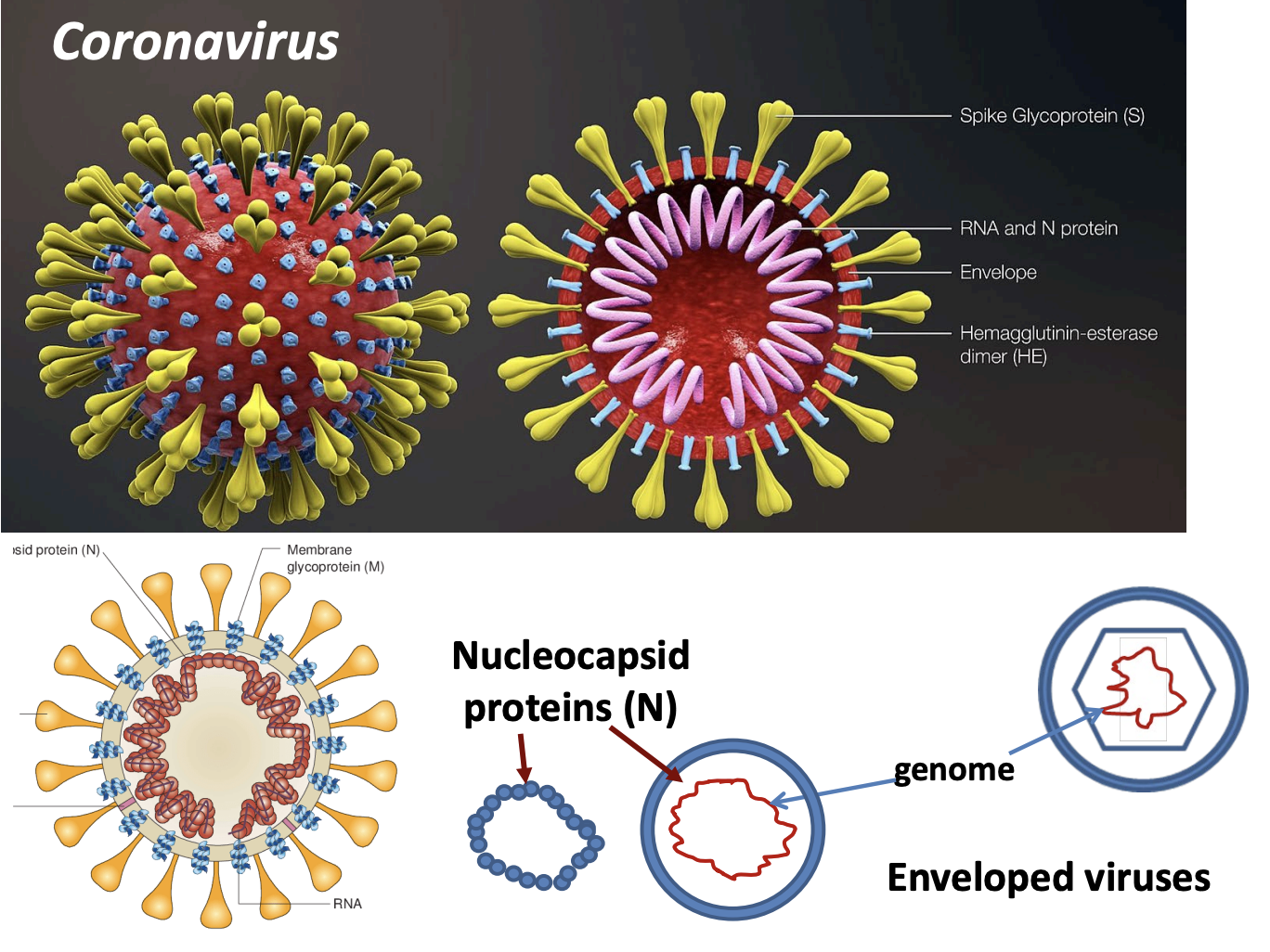
Respiratory syncytial virus and Influenza virus
Respiratory syncytial virus
Ss rna
Influenza virus
Ss rna
Segmented genomes
8
Allows many mutations
11 proteins encoded
13,500 nt bases total
Discovery of Viruses
Ivanovsky (1982) + beijerinick (1898) discovered viruses while studying Tabacco mosaic disease
They realized that the disease passed through filters that trapped bacteria - so the infectious agent was smaller than bacteria
Called them "non-filterable particles" -> later named viruses
Basic Virus Structure
Every virus has at least 2 parts
20 - 900 nm or .02 -.90 mm
Genetic material (Genome)
Protein coat (capsid)
Basic Virus Structure: Genetic material (Genome)
Can be DNA/RNA, single stranded (ss) or double stranded (ds)
Never both at once (DNA OR RNA)
Carries instructions for making viral parts
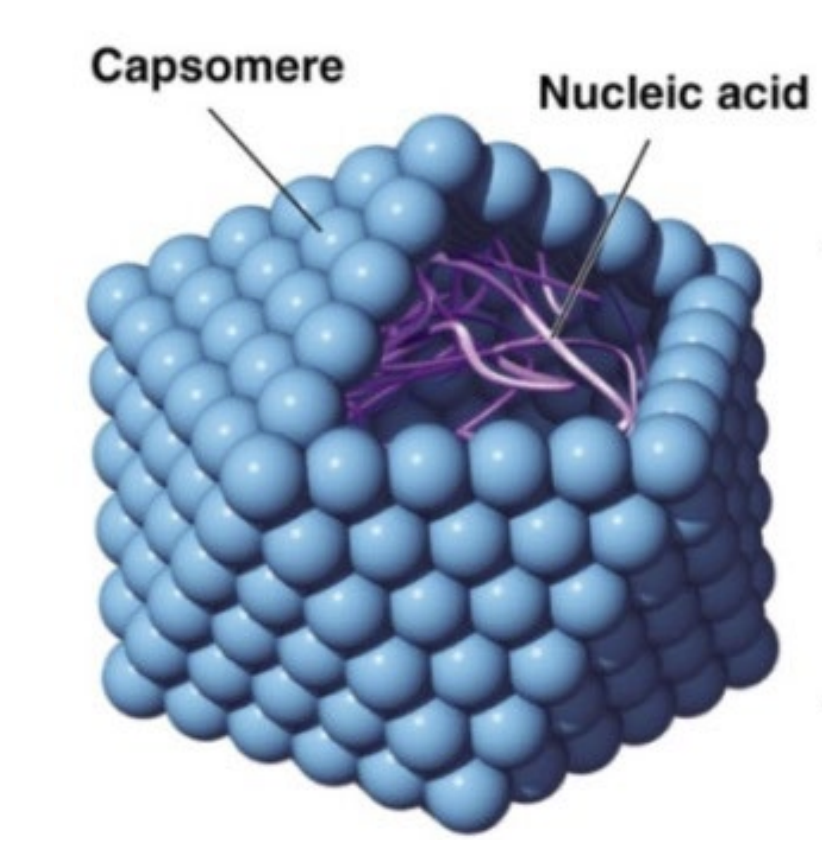
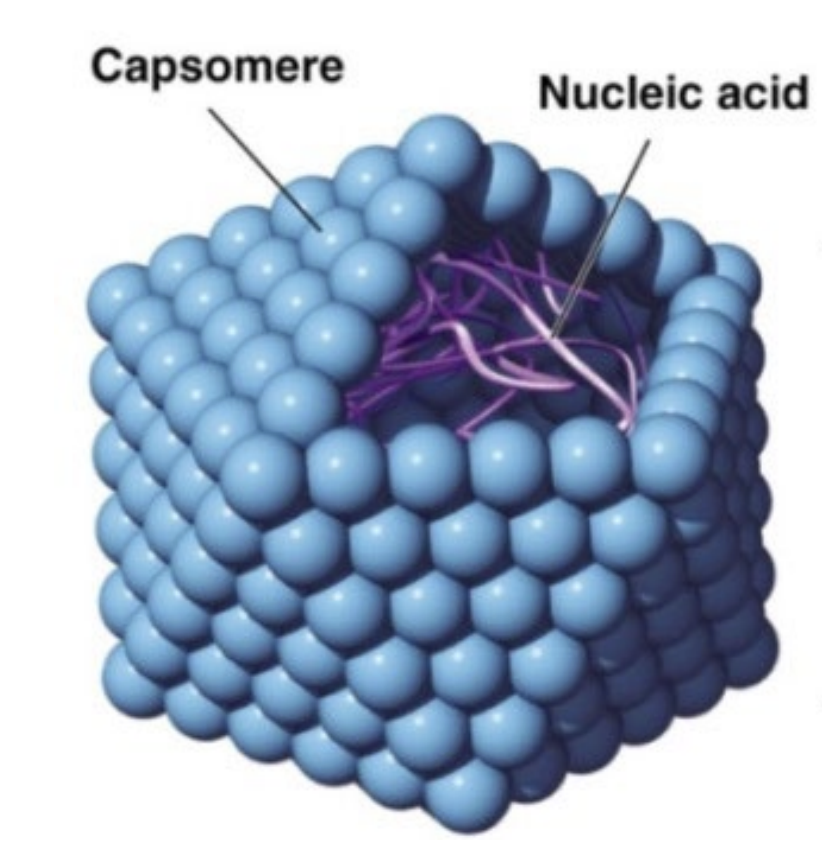
Basic Virus Structure: Protein coat (capsid)
Made of repeating protein units called capsomeres
Individual protein subunits
Protects that genetic material
Gives the virus shape
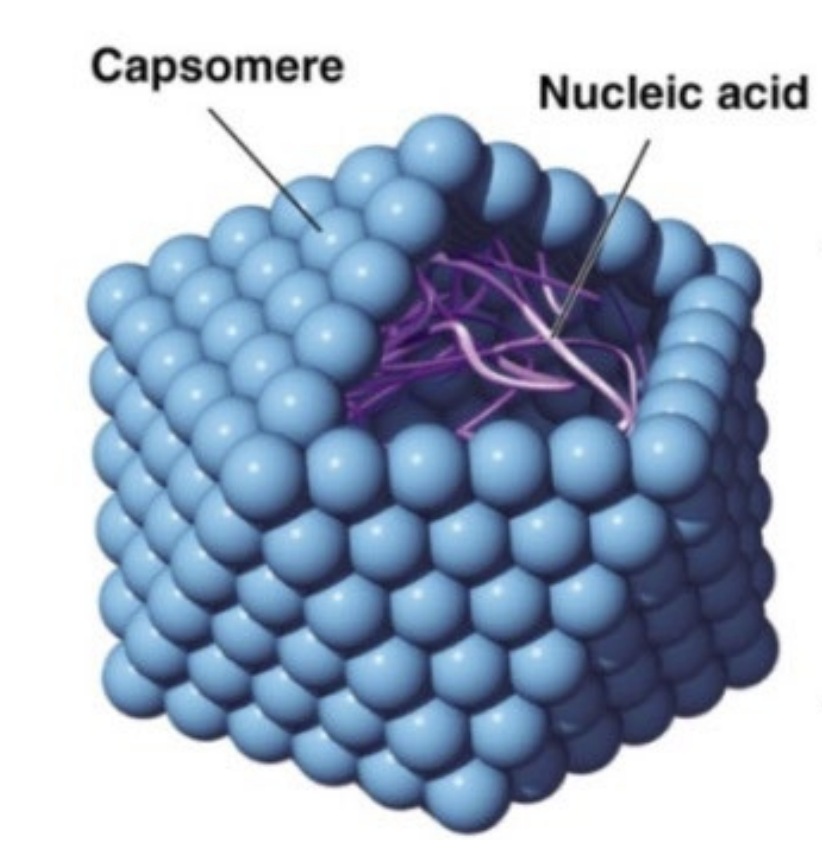
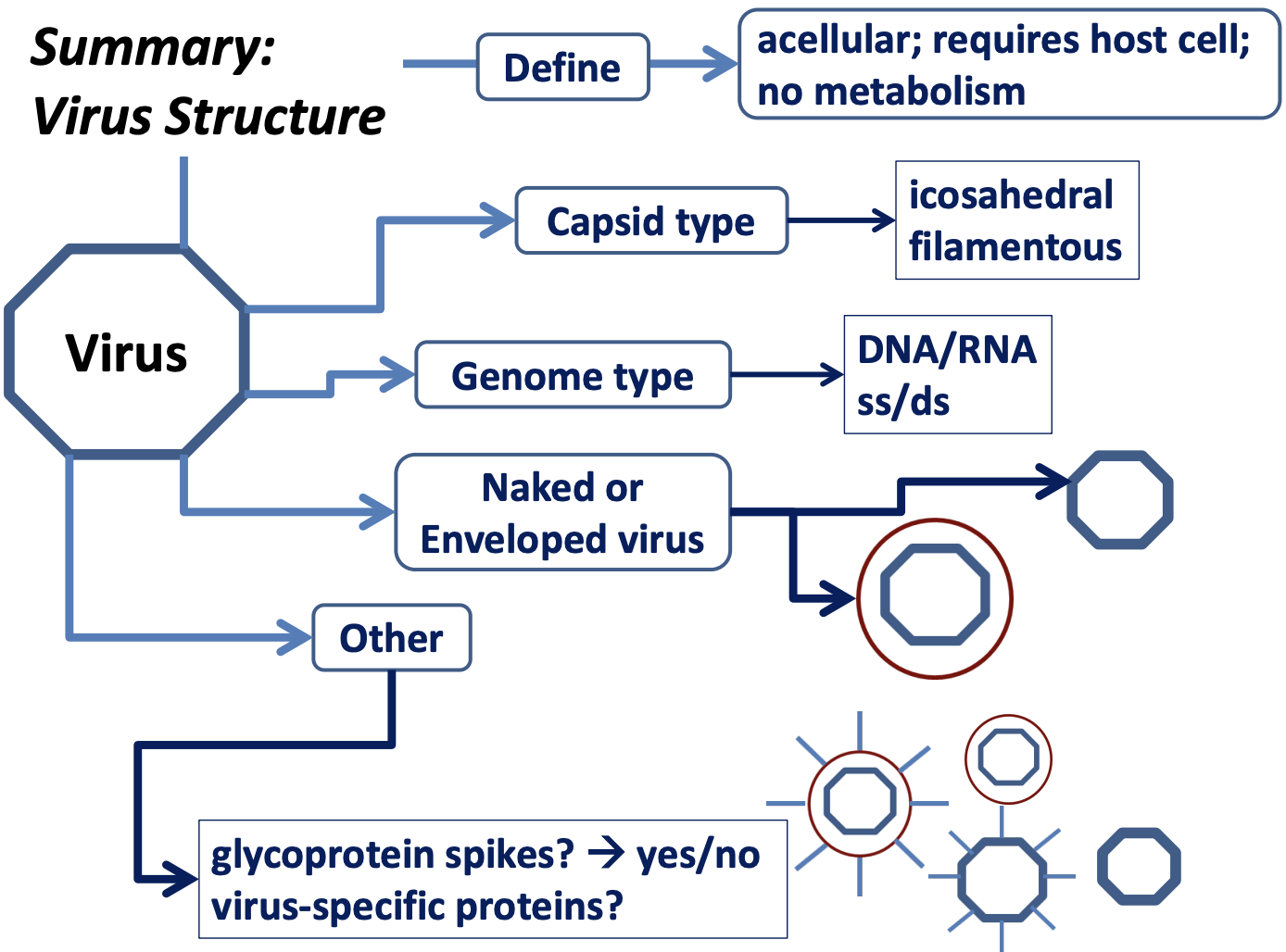
Basic Virus Structure: Some viruses have extra parts
Envelope
Naked (nonenveloped) viruses
Glycoprotein spikes

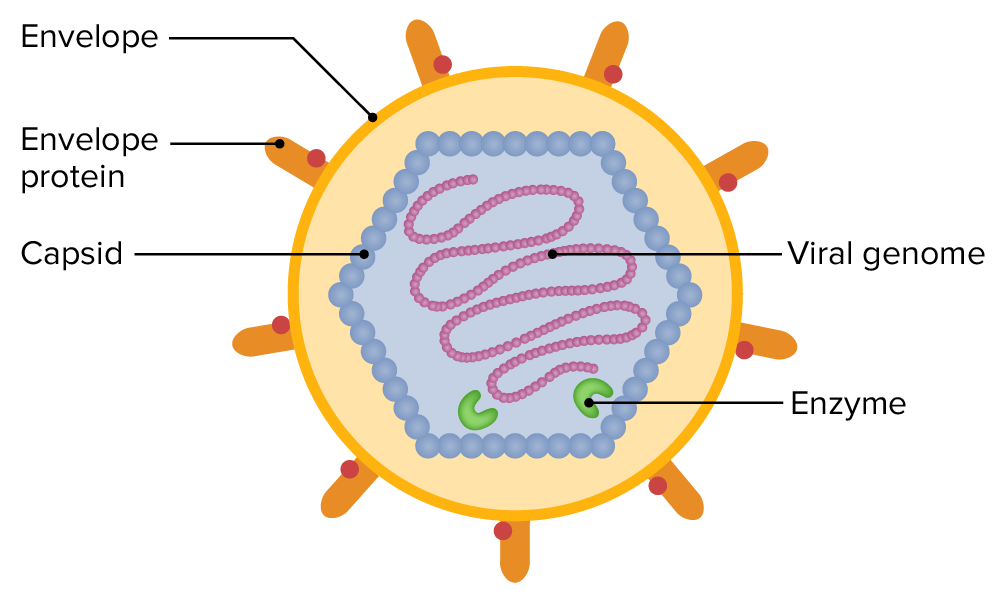
Basic Virus Structure: envelope
A membrane layer stolen from the host cells plasma membrane when the virus exits cell
Found mostly in animal viruses
Contains glycoprotein spikes for host recognition & attachment
Think of spikes like a "key" that fits the hosts "lock"
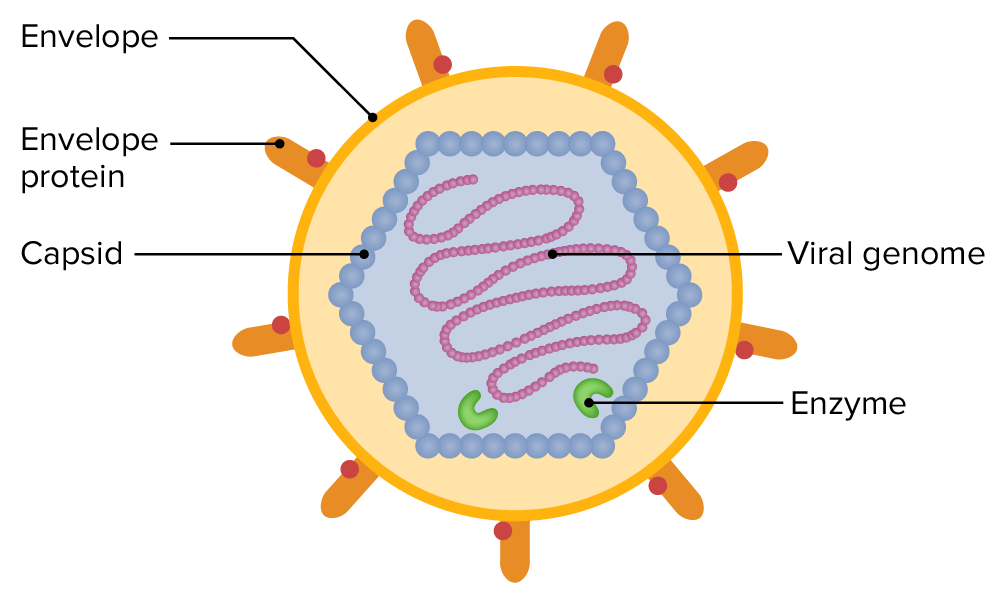
Basic Virus Structure: naked viruses
Have only a capsid and no envelope
Still can have spikes directly on the capsid
Basic Virus Structure: glycoprotein spikes
Protein structures that project from the surface of virus (either from capsid or envelope)
Proteins for host recognition
Attach to host receptors
May be present in naked viruses
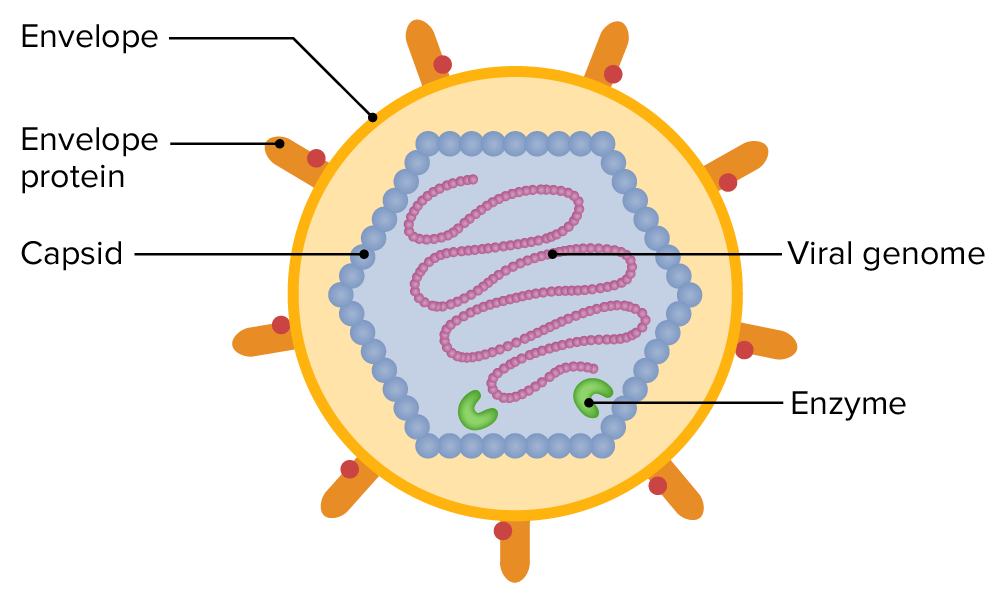
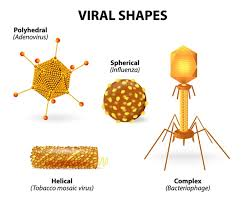
Shapes of Viruses
Capsid structure
Can vary in shape and size
;
Helical
Tube like spiral
Tobacco mosaic virus
Polyhedral (icosahedral)
20-sided shape
Adenovirus
Complex Viruses
Complicated structure
Bacteriophage
Posses non capsid protein components

Viral infectivity -> host:virus relationship
infectivity depends on virus:host recognition
Interaction between viral surface proteins and host cell surface molecules
Viral infectivity: Tissue Specificity (tropism):
Within a host, it may target only specific cells/tissues
Host cell specificity
Rabies virus infects nerve cell
Influenza infects respiratory cells
Broad
Ebola
Infect multiple cell types
Narrow
Cold virus; HIV (infects T helper cells)
Viral infectivity: Host Range
the spectrum of host organisms a virus can infect
Broad
Rabies virus
Multiple mammal hosts
Narrow range
Only infecting one species
HIV infects only humans
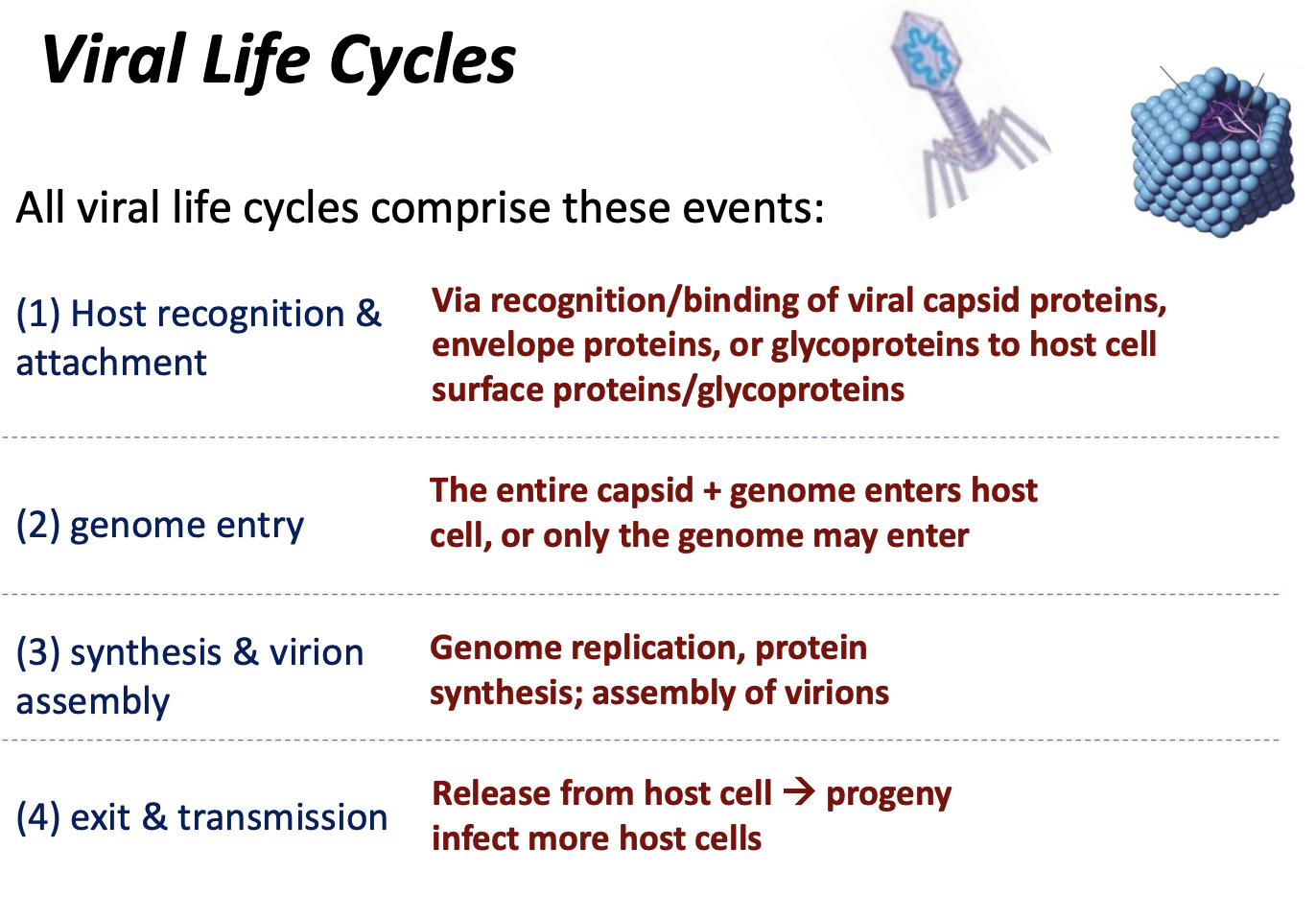
Steps of a General Viral Life Cycle
Every virus life cycle has 4 basic stages
Recognition & Attachments
Genome Entry
Synthesis & Assembly
Maturation
Exit & Transmission
Viral Life Cycle: Recognition & Attachments
Virus binds to specific proteins on the host cell surface (like matching key to lock)
Virion uses its surface proteins (spikes or capsid proteins) to bind to a specific receptor on the host cell surface
Viral Life Cycle: Genome Entry
Virus or its genome enters the cell
Sometimes whole virus enters
Sometimes only the genome is injected
Like bacteriophages
Viral Life Cycle: Synthesis & Assembly
The hosts enzymes, ribosomes, and nucleotides are stolen to make viral proteins and genomes
New viral parts assemble to complete virions
The viral genome hijacks the host cells machinery to make copies of the viral genome and transcribe/translate viral genes to produce viral proteins
This is where virus takes over
Viral Life Cycle: Maturation
The newly created genomes and proteins are put together to form new, complete virions
Viral Life Cycle: Exit & Transmission
New viruses leave the host cell:
Lysis
Cell bursts (common in bacteria)
Budding
Virus "buds off" from cell membrane (common in animal viruses w/ envelopes)
New virions infect more cells
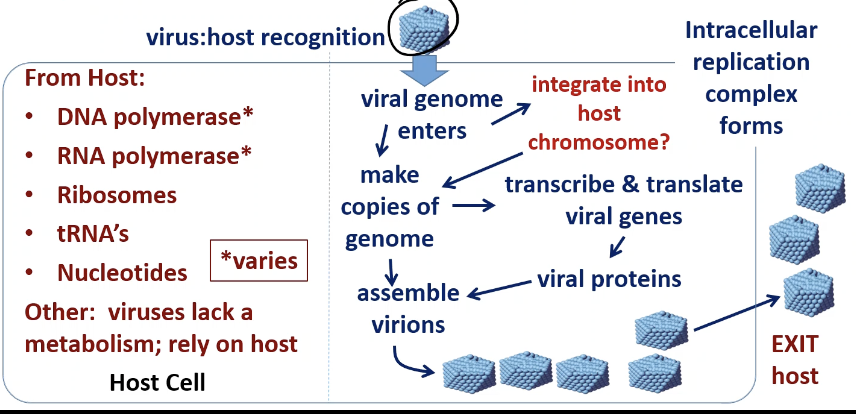
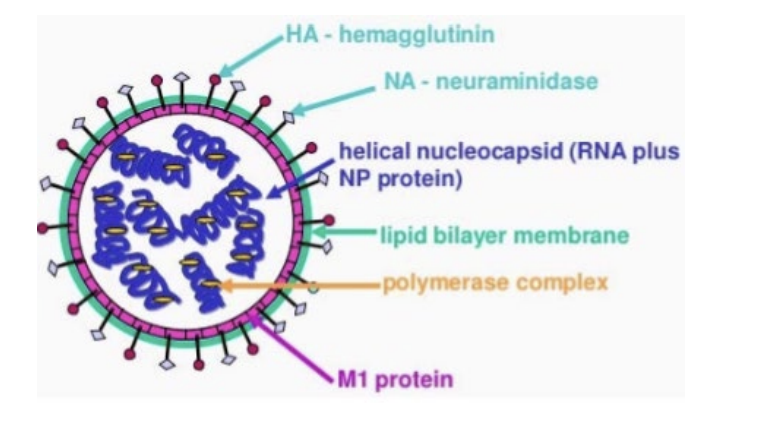
Viruses mutate faster because…
Viruses mutate faster because our cells have systems in place for mistakes RNA doesn’t
RNA
DNA can fix mistakes; not as good
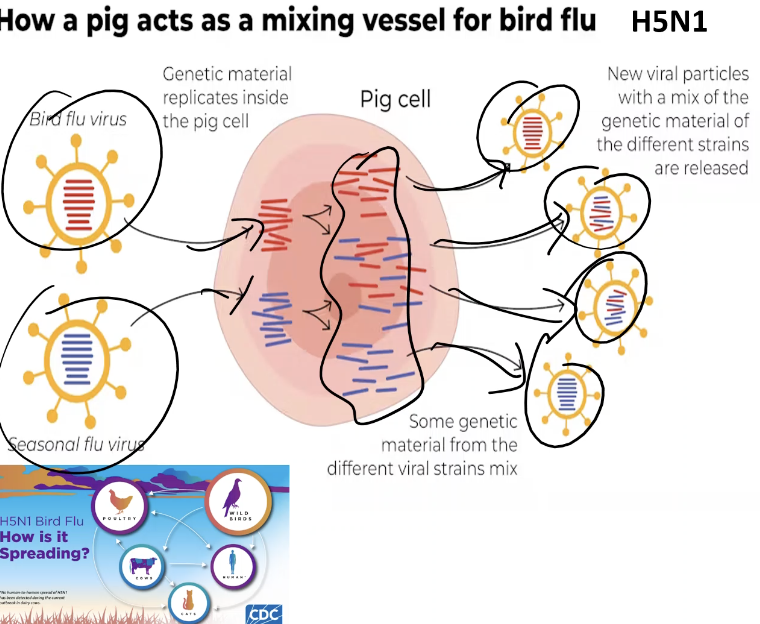
Viral Classification (Taxonomy)
Viruses are classifies by
Type of genome
DNA
RNA
Whether the genome is ss or ds
Single strand
Double strand
Envelope presence
enveloped
Naked
Capsid shape
Helical
Icosahedral
Complex
Host range
What organisms it can infect
Taxonomy
A viral species = a group of viruses with a similar genetic information and host range
Bacteriophage Life Cycles
Viruses that infect bacteria
2 major life strategies
1. Lytic Cycle
Lysogenic Cycle
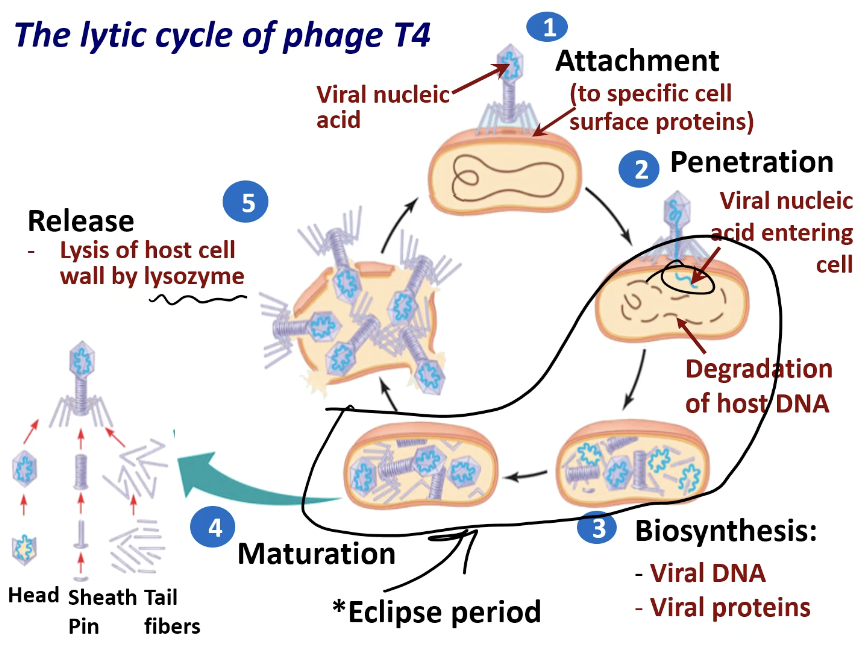
Lytic Cycle
Ex: T-even phages (like T4 which is SSRNA + )
Are virulent
Phage quickly replicates killing host cell
Steps
Attachment
Viruses attach to bacterial cell wall
Penetration
Injects its DNA into the host cell
Biosynthesis
Viral DNA takes over -> makes copies of DNA and proteins
Host DNA is destroyed
Maturation
Viral parts assemble into new virions
Release
Host cell lyses and releases new virions (50 - 500)
lysosome breaks down peptidoglycan
Eclipse period: time between viral entry and appearance of complete virions. Virions are not intact
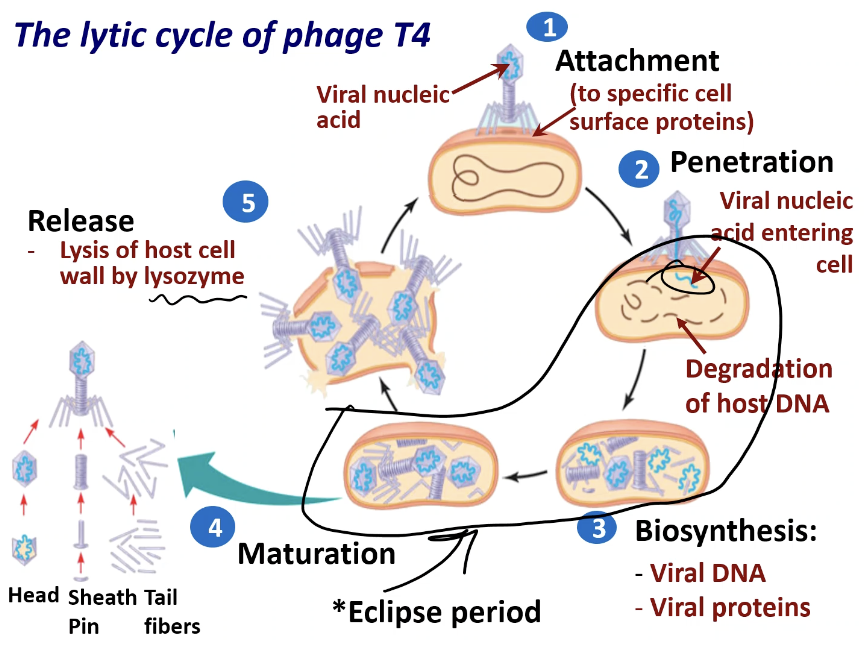
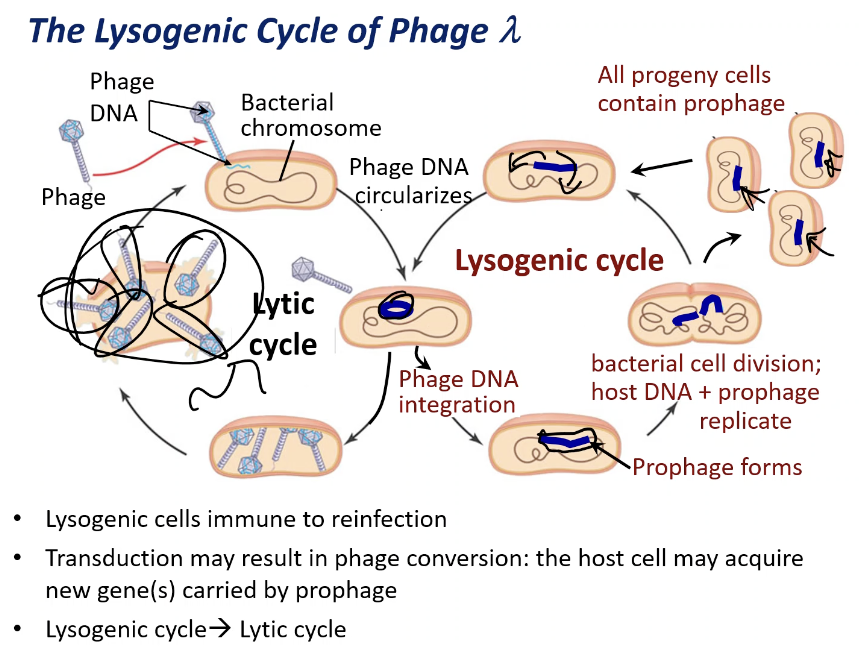
Lysogenic Cycle
Ex: lambda phage
Are temperate
The virus does not kill the host right away
Virus injects DNA
Viral DNA intergrates into host chromosome -> now called prophage
Every time the bacterial cell divides, the prophage "wakes up" and enters the lytic cycle, making new viruses and killing the host
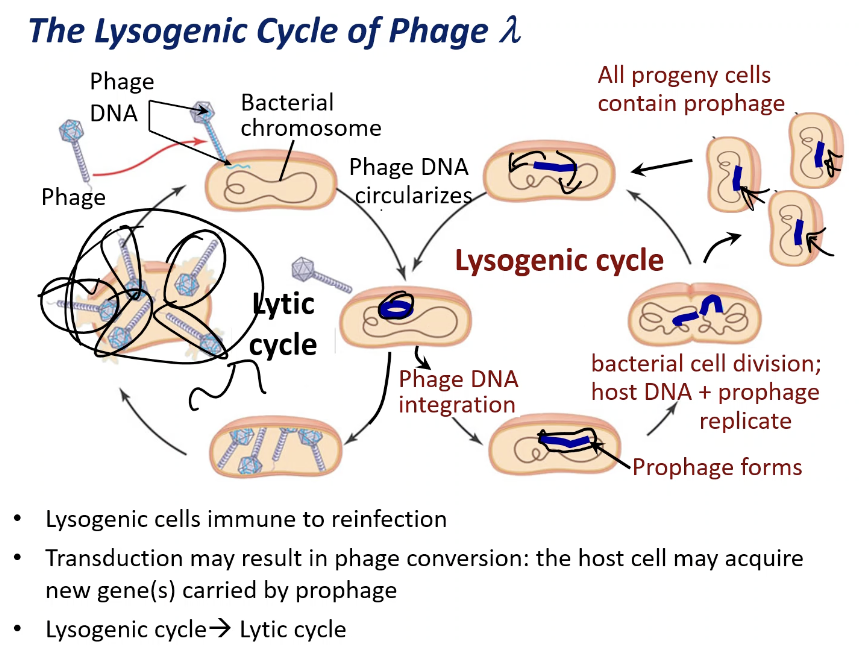
Lysogenic Cycle part 2
Will go into lytic cycle when host is healthy + dividing because there are many cells to infect
Can also when host is not doing well like lack of nutrients because they are already in dying cells and only option is lysis
Lysogenic cells are immune to reinfection by the same phage
Can lead to transduction (transfer of bacterial genes via phage)
Environmental stress triggers switch to lytic cycle
lytic vs lysogenic
Feature | Lytic Cycle | Lysogenic Cycle |
Viral DNA activity | Takes over host immediately | Integrates into host DNA (prophage) |
Host outcome | Cell bursts (dies) | Cell survives & divides |
Viral replication | Fast, destructive | Dormant until activated |
Example | T4 phage | Lambda (λ) phage |
SSRNA+ & SSRNA -
SSRNA +
Serves as mRNA
= mRNA
SSRNA -
Template for mRNA synthesis
REVIEW
Step | What Happens | Description |
1. Attachment (Adsorption) | Virus attaches to the host cell | Virus binds to specific receptor proteins on the host’s surface. |
2. Entry (Penetration) | Virus or its genome enters the cell | Can happen by fusion (envelope merges with membrane) or endocytosis (cell “eats” the virus). |
3. Biosynthesis/Replication & Assembly | Virus takes over and makes copies of itself | Host machinery makes viral proteins and genomes; parts assemble into new virions. |
4. Exit/Release | New viruses leave the cell | By lysis (cell bursts) or budding (virus pushes out through cell membrane). |

REVIEW P2
Stage | Bacteriophages | Animal Viruses |
Attachment | Tail fibers attach to cell wall proteins. | Attachment sites are plasma membrane proteins and glycoproteins. |
Entry |
Viral DNA is injected into the host cell. 44 | The entire capsid enters the host cell by receptor-mediated endocytosis or fusion. |
Uncoating |
Not required (only DNA enters). |
Required: Enzymatic removal of capsid proteins to release the genome. |
Biosynthesis | Occurs in the cytoplasm. | Occurs in the nucleus (DNA viruses) or the cytoplasm (RNA viruses). |
Chronic Infection |
Lysogeny (integration into host DNA as a prophage). |
Latency (dormant state), slow viral infections, or cancer. |
Release |
Host cell is lysed (burst open) and killed. | Enveloped viruses bud out (acquiring the envelope); nonenveloped viruses rupture the plasma membrane (lysis). |
Animal Virus Life Cycle
Attachment (adsorption)
Entry (penetration)
Uncoating
Biosynthesis
Assembly and release
Animal Virus Life Cycle: Attachment (adsorption)
Virus binds to specific receptor sites on the host cell membrane
These receptors are often glycoproteins (proteins with sugar groups)
Specificity:
The virus can only attach to cells that have the matching receptor (lock and key)
The virus uses its outer structures (capsid proteins, envelope proteins, or glycoproteins [a protein with a sugar attached]) to bind to specific receptor sites (proteins or glycoproteins) on the surface of the host cell
Difference from Bacteriophages:
Animal viruses attach to plasma membrane proteins and glycoproteins, whereas bacteriophages use tail fibers to attach to the bacterial cell wall
Animal Virus Life Cycle: Entry (penetration)
Two main entry mechanisms depending on virus type
Fusion (enveloped viruses)
The viral envelope fuses directly with the host membrane
The viral capsid and genome are released into the cytoplasm
HIV and Influenza
Receptor mediated Endocytosis (enveloped or naked)
The hosts cell plasma membrane folds inward to bring the virus, which is attached to a receptor, into a small vesicle called an endosome. This is how non enveloped and some enveloped viruses enter. (togavirus)
The host swallows the virus by forming a vesicle (called and endosome)
Inside, the virus later escapes into the cytoplasm
Animal Virus Life Cycle: Uncoating
Crucial step for animal viruses; but not bacteriophages
Capsid (protein coat) is removed, releasing the viral genome inside the host cell
Separating the genome from the capsid
The enzymatic removal of capsid proteins to separate the viral genome from its capsid
Occurs
Cell membrane
Inside endosome
Where H+ acidifies the endosome
Nuclear membrane
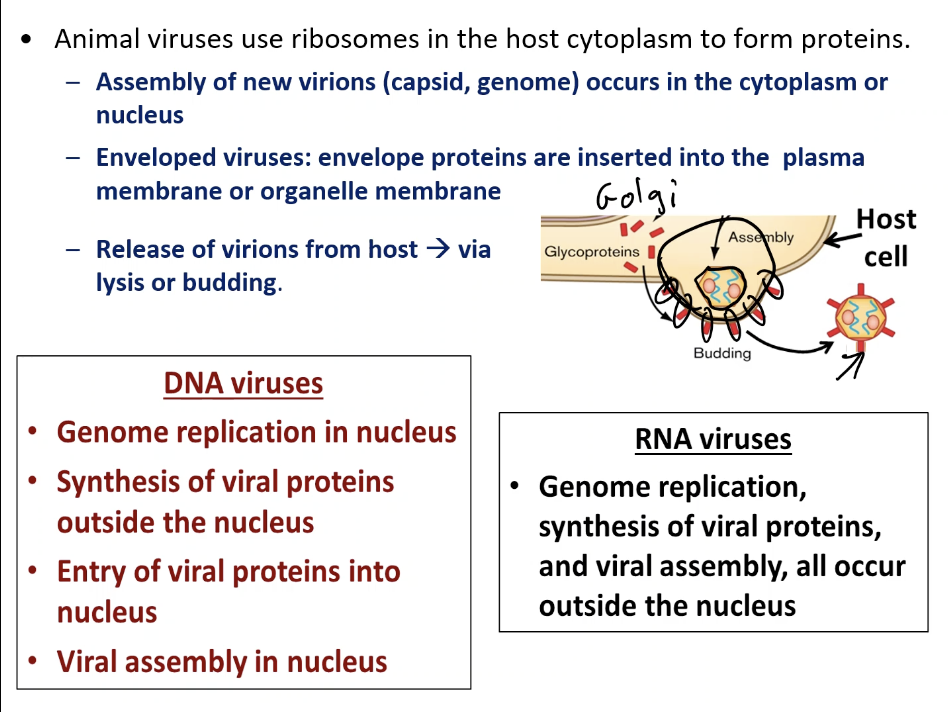
Animal Virus Life Cycle: Biosynthesis
Where the virus takes over hosts machinery
Viruses use hosts ribosomes to make viral proteins
Specific location and mechanisms depend on the viral genome type
DNA viruses
Location
Replication and assembly occur in host NUCLEUS
Why?
Need DNA polymerase to copy their genome
Mechanisms
They use the host own replication machinery (like DNA polymerase) for DNA synthesis and transcription (making mRNA)
Steps
Viral DNA is replicated in the nucleus
A portion of viral DNA is transcribed in nucleus to produce mRNA that encodes "early" viral proteins
The mRNA moves outside the nucleus (cytoplasm) to be translated into viral proteins (ex: capsid proteins) using host ribosomes
These proteins return to the nucleus where virions are assembled
RNA Viruses
Location
Replication, synthesis of viral proteins, and assembly all occur outside the nucleus (in host cells cytoplasm)
Enzyme
Typically posses their own enzyme RNA- dependent RNA polymerase (RDRP). Bc host cells don’t have an enzyme that can copy RNA from an RNA template
Animal Virus Life Cycle: Assembly and release
New viral components (capsid + genome) are assembled
Enveloped viruses:
Instert their spike proteins into the hosts plasma membrane
Virions leave by
Lysis ( usually non enveloped)
Host cell burst
Budding (usually enveloped)
Viral glycoproteins are first inserted into host cells plasma membrane
Golgi
Capsid and genome push forward, wrapping the modifies host membrane around itself as it buds off, which gives the new virion its viral envelope
Viral Genome Functions
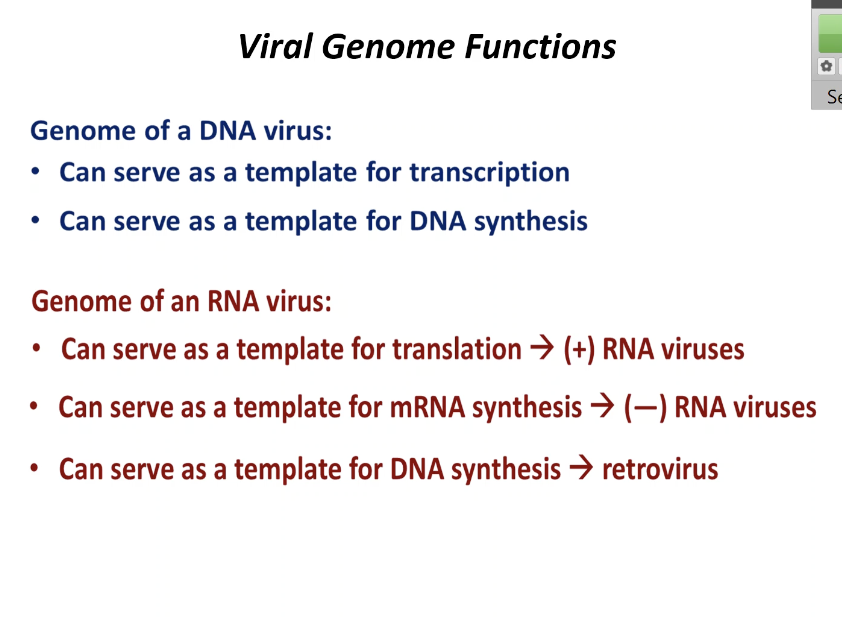
DNA VS RNA Viruses
Feature | DNA Viruses | RNA Viruses |
Where genome replicates | In nucleus | In cytoplasm |
Main enzyme used | Host DNA polymerase | Viral RNA-dependent RNA polymerase (RDRP) |
Where proteins are made | Cytoplasm (translation) | Cytoplasm |
Where virions assemble | Nucleus | Cytoplasm |
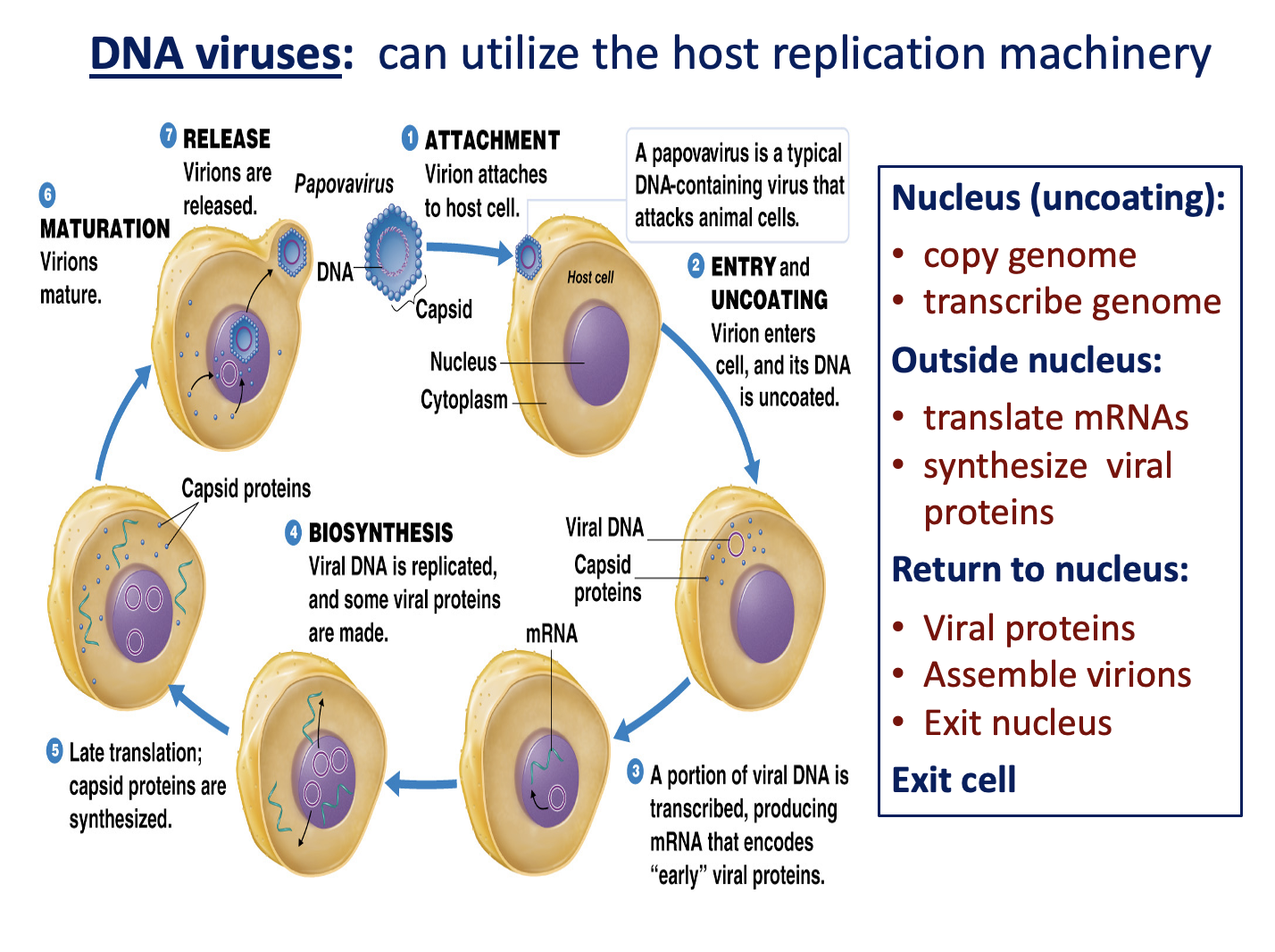
DNA Virus
Nucleus → copy genome, transcribe → cytoplasm → translate → return to nucleus → assemble → exit.
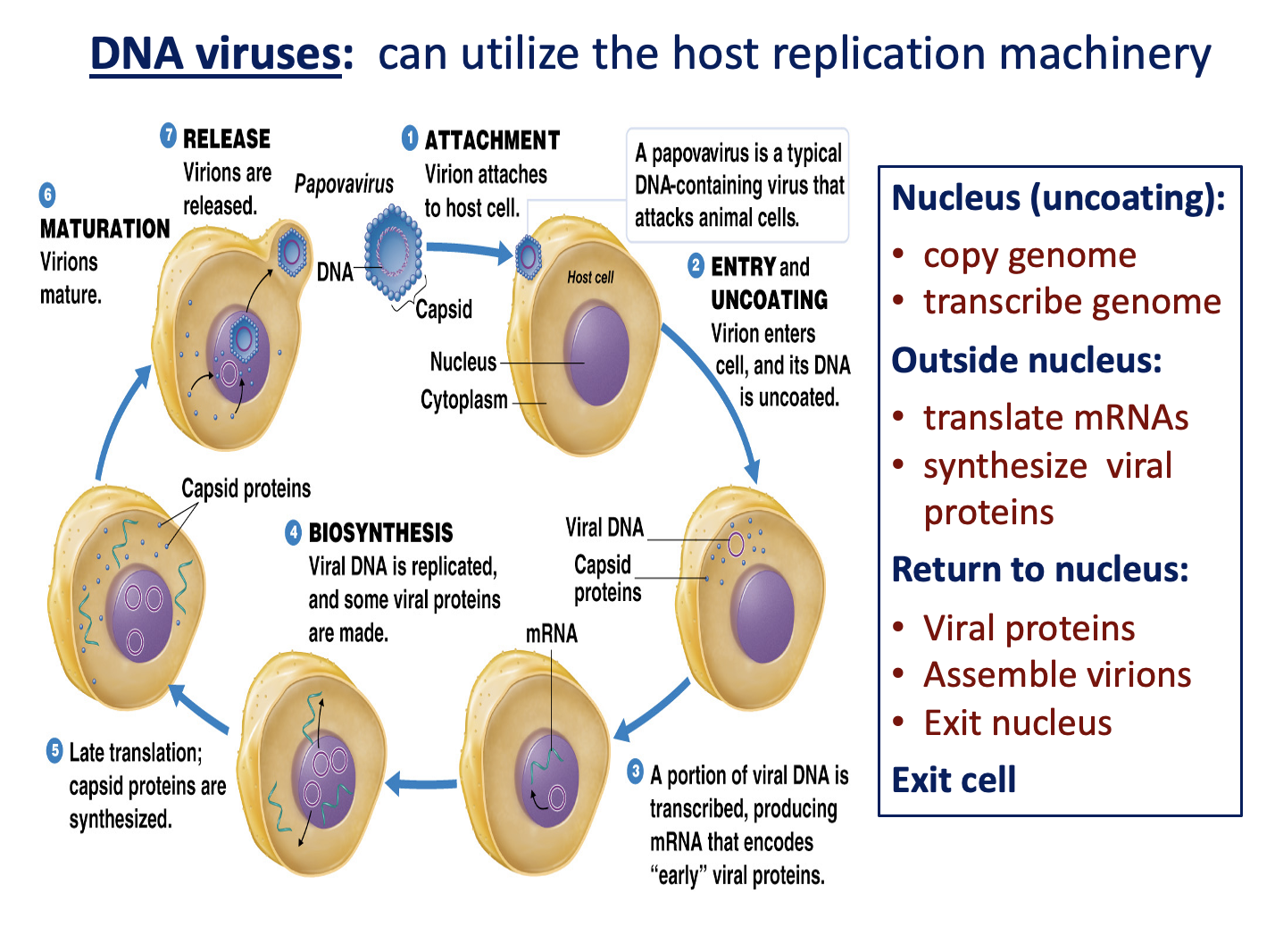
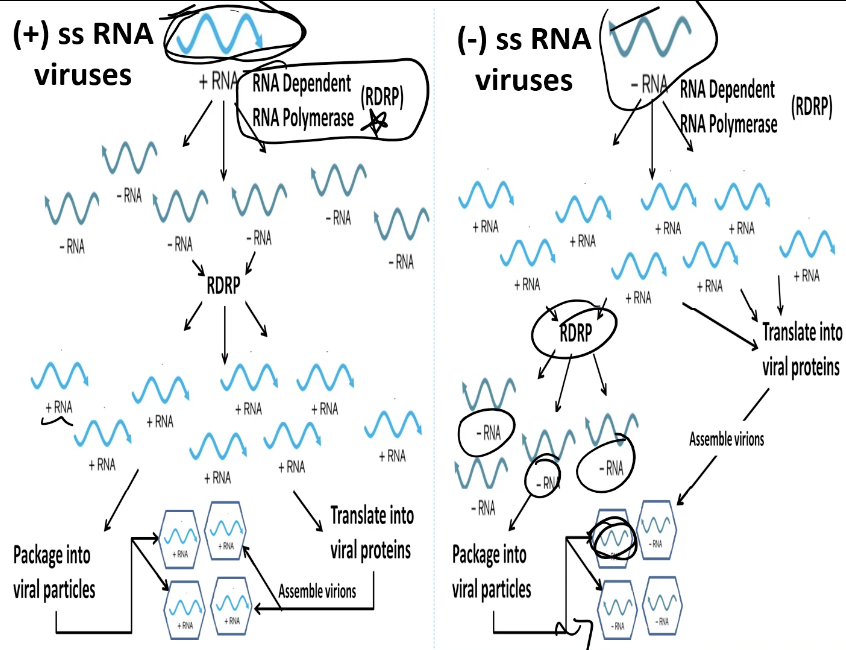
RNA Virus
Everything happens outside nucleus
Use RDRP
Makes new RNA strands using RNA as a template
+ ssRNA Viruses
Genome acts like mRNA, so it can be immediately translated by ribosomes into viral proteins
RDRP makes more copies of + RNA through a - intermediate strand
(-) ssRNA Viruses
The RNA genome cannot be directly translated
The virus must use RDRO to first make a complementary + RNA strand, which acts as mRNA
Influenza , rabies
ds RNA
Have both + and - strands
The - strand serves as a template to make more + strands
Rotavirus
Retroviruses
Enveloped RNA viruses that have a unique, backward replication process
Infects T-helper cells of the immune system
Key enzymes
Reverse transcriptase (RT)
Converts viral RNA -> double-stranded DNA
Integrase
Inserts that viral DNA into the hosts DNA -> forms provirus
Retroviruses: process
Entry
Virus enters host by fusion (bc its enveloped)
Uncoating
RNA genome and viral enzymes are released
Reverse transcription
RT enzyme copies viral RNA -> DNA
Integration
The new viral DNA integrates into the host genome (becomes provirus)
Latency
Provirus may remain inactive (persistent) for a long time
Activation
When active, the provirus makes RNA -> which makes viral proteins
Assembly & exit:
New viruses assemble and leave cell by budding
Ex: HIV (infects T-helped cells in the immune system)
Has 2 identical + RNA strands
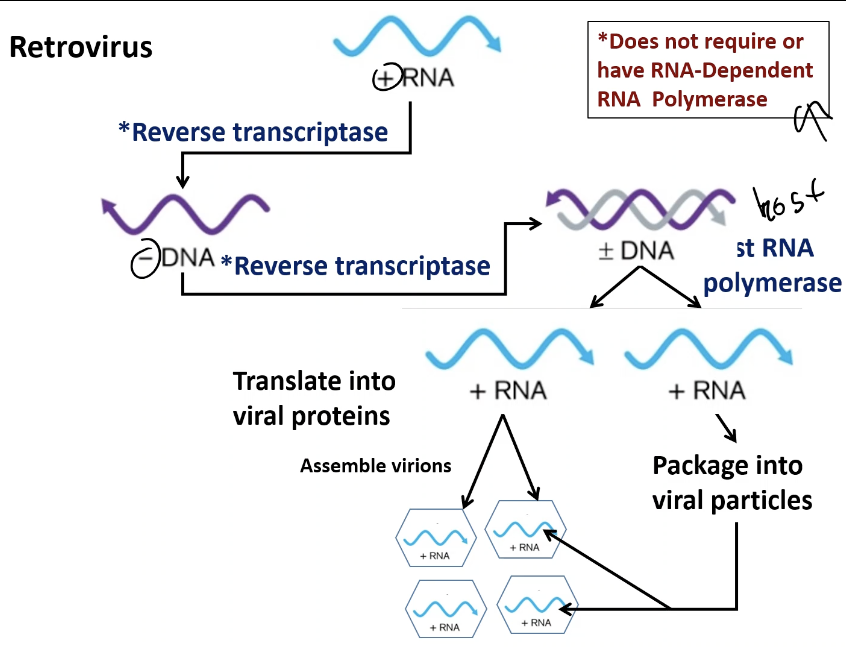
RetroVirus: Key facts
Enveloped RNA virus
Contains reverse transcriptase (NOT RDRP)
Converts RNA -> DNA -> integrates into host genome
Exits by budding
Multiplication of Animal Viruses
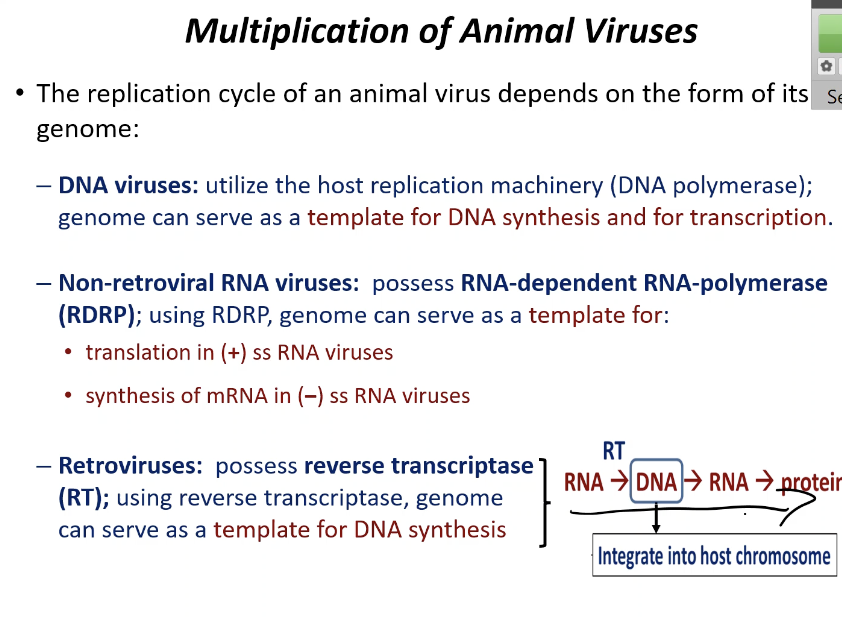
VIRIODS
Not viruses, but infectious RNA molecules
Lack a capsid (protein shell)
No structure
Infect plants only
Replicated by the hosts RNA polymerase
RNA does not code for proteins
Very small
300 - 400 nucleotides long
Some have catalytic activity
Can speed up reactions themselves, "ribozyme" function
Sits on plant mRNA so that it cant be transcripted
PRIONS
Infectious proteins (no DNA/RNA)
No nucleic acid components
Cause degenerative brain diseases in animals and humans
Spread through infected food
Like contaminated meat
Extremely resistant to heat, chemicals, and radiation
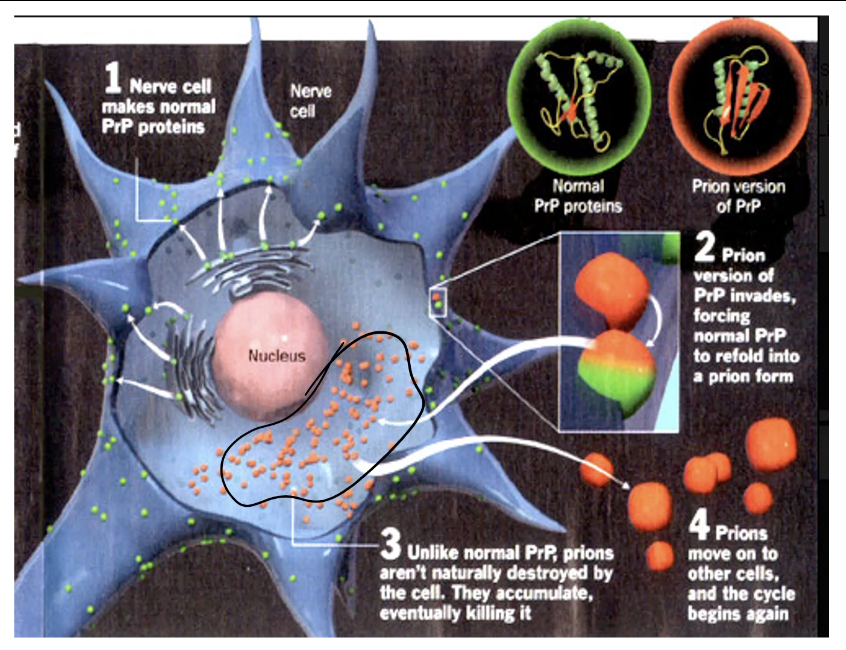
How Prions Work
The normal brain protein (PrPᶜ) is converted into an abnormal misfolded form (PrPˢᶜ)
Prp^sc binds to normal brain protein
The abnormal proteins accumulate in the brain -> forming plaques and cavities
The brain tissue becomes spongy
Disease progresses very slowly but is always fatal
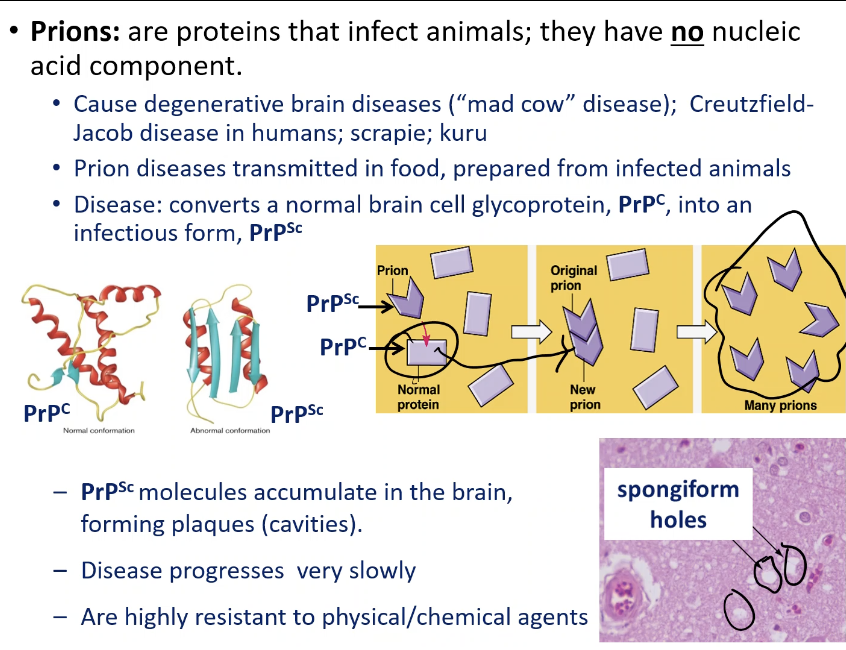
Latent infections
Latent
Virus infects host but lies dormant for long periods
Can reactivate later due to stress or weak immunity
Virus "sleeps" and can "wake up"
Oncogenic virus; herpesvirus; chicken pox (shingles
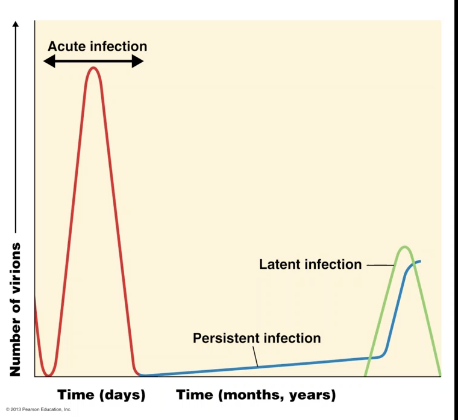
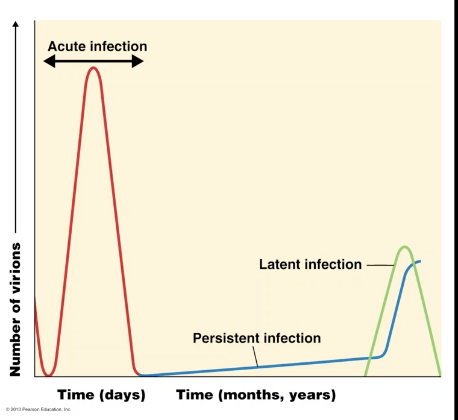
infections
Acute
Rapid onset
Short duration
Host clears virus quickly
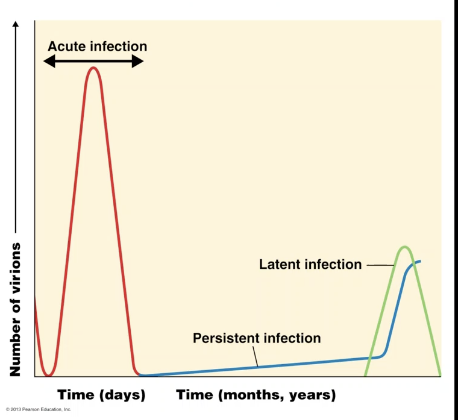
infections
Persistent (chronic)
Virus replicates slowly and continuously; may last for years and often fatal
Virus stays active the whole time
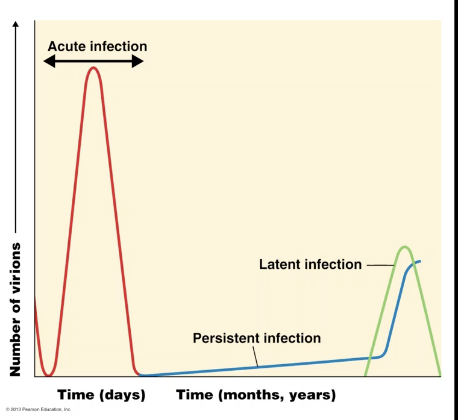
codons
